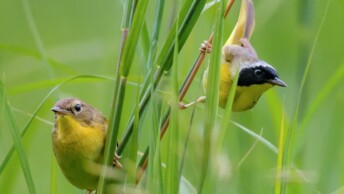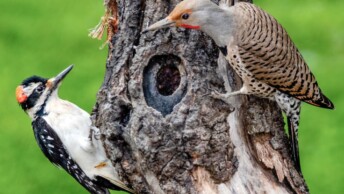The house sparrow is the UK’s most common garden bird, consistently holding the top spot in nationwide surveys for over two decades. Close behind are the blue tit, wood pigeon, starling, blackbird, and the much-loved robin, all adding color, movement, and song to gardens across the country.
In this guide, we look at the most common and frequently recorded garden birds found across the United Kingdom, including Great Britain (England, Scotland, and Wales) and Northern Ireland. For each species, we highlight key plumage details, size, and notable behaviors and vocal patterns to help with identification.
We also explore how these birds survive throughout the year and consider whether they require any support from us to continue thriving in our shared spaces.
1. House Sparrow
Passer domesticus
- Identification: Small, stocky brown-and-grey bird with males showing a black bib and chestnut nape, females plain brown with a pale eyebrow.
- Where found: Across the UK – in towns, cities, farms, and rural settlements, avoiding dense woodland.
- Region status: Native and resident, present year-round in all parts of the UK.
- Conservation status: Least Concern globally; UK populations have declined sharply due to habitat changes and reduced insect food availability.
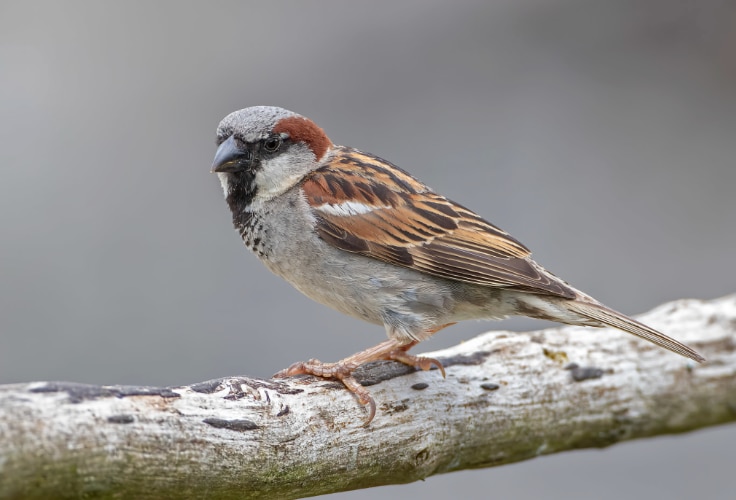
The house sparrow is the most frequently recorded garden bird in the United Kingdom, consistently topping recent surveys such as the RSPB’s Big Garden Birdwatch and other citizen science counts. It is a small resident passerine with a stout, conical bill and a compact, stocky build, measuring 14-18 centimeters (5.5-7.1 inches) in length.
Males are easily recognized by their chestnut-brown backs with black streaking, pale grey underparts, a grey crown, and a black bib that varies in size with age and breeding condition. Females and juveniles are duller, with warm brown upperparts, pale grey-buff underparts, and a soft yellowish stripe behind the eye. Juvenile males gradually develop the darker head and bib in their first year.
In flight, house sparrows move with rapid, direct wingbeats, often in noisy flocks that stay close to cover. On the ground they usually hop rather than walk, actively foraging around feeders, lawns, and paths. Their calls are simple “cheep” or “chirrup” notes, repeated in chattering bursts, with males vocalizing more frequently, especially around nesting sites.
Across the UK, house sparrows are closely associated with human habitation, thriving in gardens, parks, farmland hedges, and urban spaces such as streets and railway stations. They nest in cavities on buildings, hedges, and sometimes trees, readily using nest boxes and old nests of other species. Their diet is opportunistic, focusing on grains and seeds year-round but switching to insects during the breeding season to feed chicks.
Although still widespread, house sparrows have suffered major population declines in England since the late 20th century, linked to modern farming practices, reduced availability of invertebrate prey for nestlings, and loss of nesting sites. Populations in Scotland, Wales, and Northern Ireland have shown more stability, and garden conservation measures can help support local numbers.
2. Eurasian Blue Tit
Cyanistes caeruleus
- Identification: Tiny, active blue-and-yellow bird with a blue cap, white face, and a dark eye stripe.
- Where found: Across the UK – in woodlands, hedgerows, gardens, and parks, avoiding treeless open areas.
- Region status: Native and resident, present year-round throughout most of the country.
- Conservation status: Least Concern globally; populations are stable and supported by gardens, nest boxes, and winter feeding.

The Eurasian blue tit is a tiny, colorful bird and one of the UK’s most recognisable garden visitors, measuring 10.5-12 centimeters (4.1-4.7 inches) in length. It has a bright blue crown bordered by a white face and a narrow dark eye stripe, with greenish upperparts and vibrant yellow underparts. Males are slightly brighter than females, while juveniles in summer appear drabber with a yellowish wash across the face.
This small, restless tit moves with quick hops and short, darting flights, often hanging upside-down to forage among branches. It is a vocal species, producing a variety of high-pitched calls including thin “tsee” notes, harsh scolding churrs, and rapid twittering song phrases, especially during the breeding season.
Blue tits are widespread throughout mainland Britain and Ireland but are absent as breeders from Orkney, Shetland, and a few smaller offshore islands. They inhabit a wide range of wooded environments, from native oak and birch forests to farmland hedgerows, urban parks, and suburban gardens. They readily visit feeders, particularly in winter, and take advantage of nest boxes for breeding.
Pairs build nests in tree holes, crevices, or artificial cavities, lining them with moss and feathers. Their diet includes small insects, spiders, and caterpillars in spring and summer, switching to seeds, nuts, and household scraps during colder months.
Their UK population has remained stable, supported by widespread winter feeding and an abundance of nest boxes. Though harsh winters can cause local declines, blue tits have adapted well to human-modified landscapes, making them a familiar sight year-round.
3. Common Wood Pigeon
Columba palumbus
- Identification: Large grey pigeon with a pinkish breast, white neck patch, and bold white wing bars visible in flight.
- Where found: Across the UK – in woodlands, farmland, parks, and gardens, but scarce on some northern islands.
- Region status: Native and resident year-round, with numbers boosted in winter by migrating birds from northern Europe.
- Conservation status: Least Concern globally; populations are stable and even increasing.

The common wood pigeon is the UK’s largest and most abundant pigeon, measuring 38-45 centimeters (15-17.7 inches) in length. Its plumage is mostly bluish-grey with a pinkish mauve breast and creamy underbelly. The neck shows white patches that catch green and purple iridescence, and in flight the broad white wing bars are especially striking.
In flight, wood pigeons often take off with a loud wing clatter and display a characteristic flap-flap-flap climb followed by a smooth glide. Their call is a deep, rhythmic series of coos – “rhu-rhoooh-rhoo-rhu-rhu,” often repeated continuously from perches in woodland or gardens.
Wood pigeons are found in a wide range of habitats, from deciduous and mixed woodlands to farmland, grasslands, urban parks, and suburban gardens. They are abundant on the mainland UK but scarce on some northern offshore islands. While primarily resident, their numbers increase in autumn and winter as migrants from Scandinavia and northern Europe join local populations, forming large flocks.
They build simple twig nests in trees, hedges, or sometimes on building ledges, and raise multiple broods each year. The diet is varied and largely plant-based, including grains, seeds, buds, leaves, and berries, but they also take invertebrates occasionally.
Though considered a pest in some agricultural areas due to damage to crops like oilseed rape, the species is thriving in Britain and has adapted well to human-modified landscapes, becoming a familiar sight across the country year-round.
4. Common Starling
Sturnus vulgaris
- Identification: Medium-sized, stocky bird with a short tail and pointed wings, glossy purple-green in breeding plumage and spangled with white spots in winter.
- Where found: Across the UK – in towns, farmland, gardens, and open countryside.
- Region status: Native and resident, with numbers increasing in winter as migrants arrive from northern Europe.
- Conservation status: Least Concern globally; in the UK, severe declines due to agricultural changes have placed it on the Red List.

The common starling is a compact, highly social garden bird measuring 19-23 centimeters (7.5-9.1 inches) in length. At a distance it appears uniformly dark, but close up the plumage shimmers with purple and green iridescence in spring and summer. In winter, it takes on a browner appearance with extensive white spots across the body. Juveniles are dull grey-brown before gradually moulting into adult plumage.
Starlings have a fast, direct flight with triangular wings, and they walk or run confidently on the ground rather than hopping. They are exceptionally vocal, producing a wide range of whistles, clicks, and squeaks, often mimicking the calls of other birds. Outside the breeding season, they gather in dense flocks that move with striking synchrony, forming the famous swirling murmurations at dusk.
In the UK, starlings thrive in a variety of open and semi-open habitats, from farmland and coastal marshes to towns, city parks, and gardens, though they are scarcer in parts of the Scottish Highlands and some remote islands. They nest in cavities, readily using gaps in buildings, nest boxes, or old woodpecker holes. During spring and summer they feed mainly on soil invertebrates, especially leatherjackets and other insects, while in autumn and winter they turn to berries, seeds, and scraps.
Though still common in gardens and urban areas, their breeding population has declined sharply since the 1970s, linked to intensive farming, loss of pastureland, and reduced food availability for chicks. In winter, resident birds are joined by large numbers from northern Europe, creating spectacular seasonal roosts that may contain tens of thousands of individuals.
5. Common Blackbird
Turdus merula
- Identification: Medium-sized thrush; males are glossy black with a bright yellow bill, females and juveniles are brown with streaked breasts.
- Where found: Across the UK – in gardens, parks, woodland edges, and farmland.
- Region status: Native and resident year-round, with the population increasing in winter as migrants arrive from northern Europe.
- Conservation status: Least Concern globally; still common in the UK despite some local declines linked to habitat changes.

The common blackbird is a familiar medium-sized bird measuring 24-29 centimeters (9.5-11.4 inches) in length. Males are entirely black with a vivid orange-yellow bill and a matching eye-ring, while females are dark brown, often paler and streaked below with a brownish bill. Juveniles are similar to females but show buff spotting on the back and breast.
On the ground, blackbirds walk and run with a distinctive upright posture, pausing to tilt their heads as they search for food. Their song is one of the most melodious of any British garden bird – rich, mellow, and flute-like, delivered from elevated perches in the breeding season. They also give a sharp “tchook” alarm call when disturbed.
Blackbirds occupy a wide variety of habitats, from woodland and farmland hedgerows to city parks, suburban gardens, and coastal scrub, though they are absent from the highest Scottish mountains where the ring ouzel (Turdus torquatus) replaces them. They build sturdy, mud-lined nests in trees, shrubs, climbing plants, and sometimes on buildings. Their diet is highly varied: earthworms and insects form the staple in spring and summer, while berries and fallen fruit dominate in autumn and winter.
Although widespread and thriving in many habitats, UK populations have shown some regional declines since the 1970s, likely linked to agricultural intensification and reduced food availability in farmland. Despite these pressures, the species has adapted well to human-modified landscapes, remaining one of the country’s most common and best-loved garden birds.
6. European Robin
Erithacus rubecula
- Identification: Small olive-brown bird with bright orange-red face and breast bordered by bluish-grey, whitish belly, and pinkish-brown legs.
- Where found: Across the UK – in gardens, woodlands, parks, and hedgerows, staying close to cover.
- Region status: Native and largely resident; some females migrate to southern Europe in winter.
- Conservation status: Least Concern globally; stable in the UK, though still subject to winter trapping in the Mediterranean.
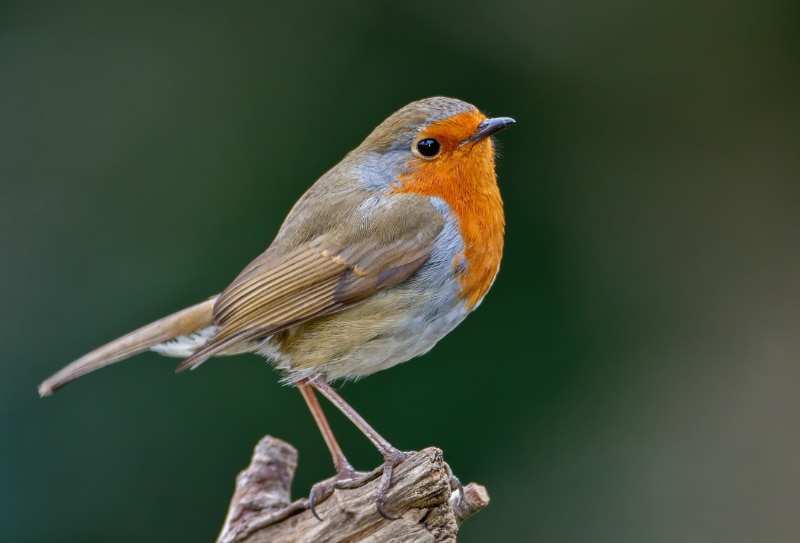
The European robin is a small, easily recognized garden bird found throughout the United Kingdom, measuring 12.5-14 centimeters (4.9-5.5 inches) in length. Adults have a vivid orange-red face and breast framed by a subtle bluish-grey border, olive-brown upperparts, whitish belly, and fine pinkish-brown legs. Males and females are identical in plumage, but juveniles are completely different – spotted golden-brown without any red breast.
In gardens and woodlands, robins are often seen hopping on the ground, pausing with a characteristic flick of the wings or tail before darting to a low perch. Their high, silvery, and slightly melancholic song is delivered almost year-round, even at night near street lights, while their sharp “tic” call reveals territorial disputes.
Robins inhabit gardens, parks, hedgerows, and woodland edges, especially where shady cover and open ground for foraging are present. They nest low in recesses, ivy-covered walls, tree roots, or nest boxes, building a moss-lined cup hidden in vegetation. Their diet is mainly invertebrates such as beetles, flies, spiders, and earthworms, supplemented by fruits and seeds in autumn and winter.
British robins are mostly resident, though some females migrate to southern Europe, while winter migrants from Scandinavia add to local numbers. Populations remain stable in the UK, but trapping and hunting in parts of the Mediterranean still affect some migrating individuals.
7. Great Tit
Parus major
- Identification: Large tit with green back, bright yellow underparts, black head with white cheeks, and a black stripe down the belly.
- Where found: Across the UK – in woodlands, parks, gardens, and hedgerows, often near feeders.
- Region status: Native and resident year-round, forming mixed winter flocks with other tits.
- Conservation status: Least Concern globally; UK populations have increased but face some urban breeding challenges.
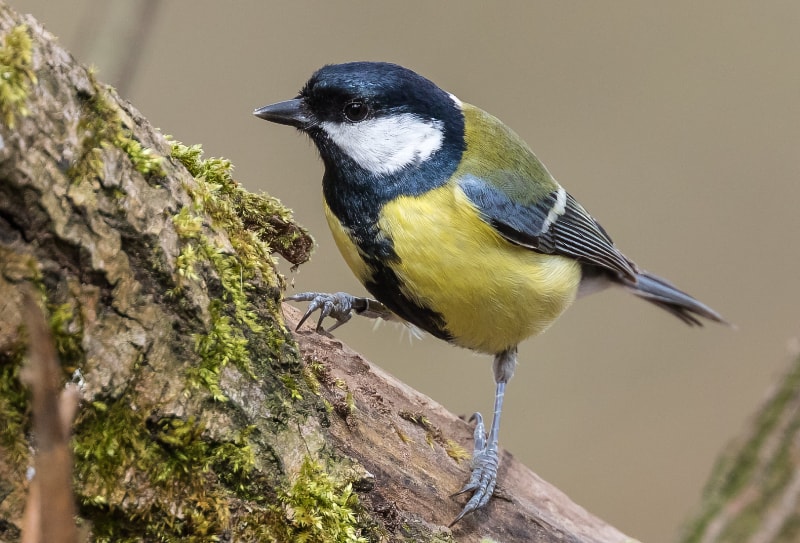
The great tit is the largest and most boldly marked tit in the United Kingdom, measuring 12.5-15 centimeters (4.9-5.9 inches) in length. Adults have a glossy black head with striking white cheeks, a green back, blue-grey wings with a single white wing bar, and bright yellow underparts crossed by a distinctive black stripe that is broader in males than females. Juveniles are duller overall, with a yellowish wash to the face and softer markings.
Great tits are highly active, hopping and clambering through branches or along walls, often pausing before darting to feeders or perches. Their song is a clear, high-pitched two-note “tea-cher, tea-cher” phrase, repeated insistently, while calls include a metallic “tink” and harsh churring scolds when alarmed.
In the UK, great tits occupy a wide range of habitats, from deciduous and mixed woodlands to urban gardens, hedgerows, and parks. They readily nest in natural cavities, tree holes, or artificial nest boxes, lining their nests with moss, feathers, and fur. Their diet consists mainly of insects and caterpillars during the breeding season, shifting to seeds, nuts, and food scraps in winter.
Although highly adaptable, urban populations can have lower breeding success compared to forest populations due to reduced food quality and noise pollution affecting vocal behavior. Nevertheless, their UK numbers have steadily increased in recent decades, supported by widespread use of feeders and nest boxes in gardens.
8. European Goldfinch
Carduelis carduelis
- Identification: Small, colorful finch with a bright red face, black-and-white head, yellow wing bar, and white rump seen in undulating flight.
- Where found: Across the UK – in gardens, parks, hedgerows, and open woodland, often feeding on thistles and teasels.
- Region status: Native and mostly resident; some migrate in winter to southern Europe.
- Conservation status: Least Concern globally; stable and increasing in the UK thanks to milder winters and garden feeding.
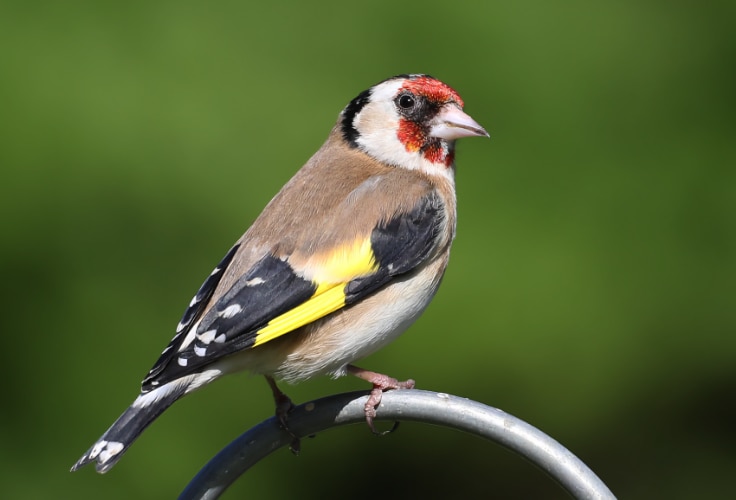
The European goldfinch is a striking and sociable finch commonly seen in gardens and open countryside across the United Kingdom, measuring 12-15 centimeters (4.7-5.9 inches) in length.
Adults have a vivid red face surrounded by black-and-white markings, a fine pink bill, a warm brown back, and a black tail with white spots. Their black wings are marked by a brilliant yellow patch that flashes in flight. Juveniles lack the red face and have a plain streaky brown head and body but already show the yellow-and-black wing pattern.
Goldfinches are lively and agile, often feeding acrobatically on seed heads and visiting feeders. Their soft tinkling, twittering calls and flowing liquid song often give away their presence before they are seen.
The species breed in loose colonies in gardens, parks, hedgerows, and woodland edges, preferring areas with scattered trees and abundant seed plants such as teasels and thistles. Nests are built high on outer branches of trees or shrubs, carefully hidden in foliage. Their diet consists mainly of seeds, buds, and flowers, with insects occasionally fed to chicks.
While many UK birds remain year-round, some move south in winter, and northern European birds may join local flocks. Populations have grown in recent decades, supported by garden feeders, milder winters, and reduced bird-trapping compared to the past, making the goldfinch a more frequent garden visitor than in previous generations.
9. Eurasian Magpie
Pica pica
- Identification: Large, long-tailed black-and-white bird with blue-green iridescence on wings and tail in good light.
- Where found: Across most of the UK – in farmland, parks, gardens, hedgerows, and open woodland.
- Region status: Native and resident year-round, forming flocks outside the breeding season.
- Conservation status: Least Concern globally; stable in the UK with high adaptability to urban areas.

The Eurasian magpie is a large, striking, and unmistakable bird found across most of the United Kingdom, measuring 44-50 centimeters (17.3-19.7 inches) in length, with nearly half of this made up by its long, graduated tail.
It has bold black-and-white plumage, a glossy black head and upperparts with a subtle green and purplish-blue sheen, white scapulars and belly, and black wings marked with a distinctive white patch. The long tail shimmers with blue and green iridescence in sunlight.
Magpies are active, bold, and often noisy, moving with a confident, strutting gait on the ground. Their loud, explosive “chak-chak-chak” chatter is a familiar sound, sometimes interspersed with questioning “ch-tak?” notes and softer warbles.
In the UK, magpies thrive in open countryside with scattered trees, farmland, hedgerows, parks, and increasingly in urban and suburban areas where they reach high densities, though they are largely absent from much of northern and western Scotland. They build large domed nests of twigs high in trees, hedgerows, or even on buildings, lining them with soft materials like wool or feathers.
Omnivorous and opportunistic, they feed on insects, small mammals, eggs, nestlings, carrion, seeds, berries, and food scraps, even perching on livestock to pick off ectoparasites. Magpies cache food but usually retrieve it within a few days.
While often seen in pairs during breeding, they form larger flocks in winter for roosting and feeding. Their UK populations remain stable and adaptable, benefiting from their generalist diet and tolerance of human-altered landscapes.
10. Long-Tailed Tit
Aegithalos caudatus
- Identification: Tiny, round-bodied bird with fluffy white and pink-tinged plumage, black markings, and an extremely long tail.
- Where found: Across most of the UK – in woodland edges, hedgerows, scrub, parks, and gardens.
- Region status: Native and resident year-round; scarce in parts of northern Scotland.
- Conservation status: Least Concern globally; populations stable but vulnerable to harsh winter weather.

The long-tailed tit is a small, sociable bird with a round body and a remarkably long, narrow tail, making up more than half its total length of 13-16 centimeters (5.1-6.3 inches). Adults have a fluffy white head with a black eyebrow stripe running down the back, pale pinkish flanks, and black wings flecked with white. Juveniles are darker, with brownish tones around the face and shorter tails, but still show the same compact shape.
Long-tailed tits move in lively, chattering flocks of 10-20 birds, often flicking through hedgerows or darting between trees with a bouncing flight. Their soft, high-pitched “see-see” and trilling “tsirr” calls keep the group together, especially in winter when they forage communally.
This species inhabits woodland edges, scrub, hedgerows, parks, and well-vegetated gardens, avoiding dense forests but thriving in semi-open habitats across most of the UK, though they are less common in parts of northern Scotland. They build intricate domed nests low in thorny bushes or trees, made from moss, cobwebs, and lichen, and lined with thousands of tiny feathers for insulation. Their diet consists mainly of small insects and spiders, with seeds and buds added in autumn and winter.
Harsh winters can reduce their numbers significantly, sometimes causing local declines of up to 80%, but mild conditions and widespread garden feeding help populations recover within a few years. Although vulnerable to habitat fragmentation and nest predation, their adaptability to mixed habitats and social flocking behavior support stable long-term populations.
11. Eurasian Jackdaw
Coloeus monedula
- Identification: Small, sociable black crow with a pale silvery-grey nape and striking whitish eyes.
- Where found: Across most of the UK – in towns, villages, farmland, parks, and sea cliffs, avoiding dense forests and highlands.
- Region status: Native and resident year-round; winter numbers increase with visitors from northern Europe.
- Conservation status: Least Concern globally; UK breeding population has increased since the 1960s and remains stable.
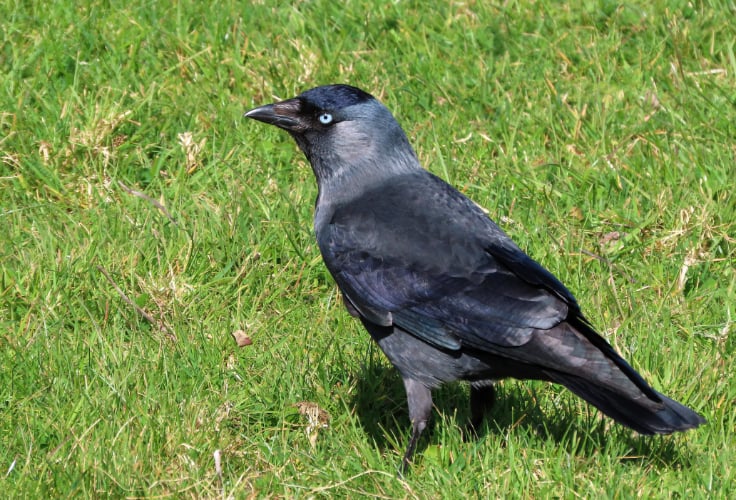
The Eurasian jackdaw is the smallest of the UK’s crows, measuring 34-39 centimeters (13.4-15.4 inches) in length, with a shorter, rounded tail and a more delicate build than rooks (Corvus frugilegus) or carrion crows (Corvus corone).
Adults are sleek black with a contrasting silvery-grey nape and sides of the neck, a black cap and forecrown, and distinctive pale whitish eyes that give an alert, inquisitive expression. Juveniles appear browner with darker eyes and duller head markings.
Jackdaws are confident walkers, often seen in pairs or small groups exploring pavements and rooftops, and are agile fliers, performing playful tumbling aerobatics. Their calls are clear, ringing “jack” or “chack” notes, often repeated in chatter, which gives the species its name.
The species inhabits a wide variety of open and semi-open habitats across the UK, from farmland, hedgerows, and wood pasture to villages, parks, churchyards, and coastal cliffs, though it is scarcer in the far north of Scotland. They readily nest in chimneys, old buildings, tree cavities, and rock crevices, lining their twig-based nests with softer materials such as moss, wool, and feathers.
Their diet is highly varied, including insects, seeds, fruits, scraps, and occasionally eggs or nestlings. Outside the breeding season, they gather in large flocks, sometimes with rooks, creating impressive dusk roost displays.
UK numbers have increased steadily since the 1960s, benefiting from a mix of rural and urban nesting sites. In winter, local populations are joined by migrants from northern Europe, making jackdaws a familiar and abundant sight in most lowland areas.
12. Rock Pigeon (Feral Pigeon)
Columba livia
- Identification: Medium-sized pigeon with pale grey body, two bold black wing bars, iridescent green and purple neck sheen, and a white rump.
- Where found: Wild birds are confined to rocky coasts and islands in north and west Scotland and Northern Ireland; feral pigeons thrive in towns, cities, farmland, and around cliffs across the UK.
- Region status: Native in wild form; feral populations are resident year-round and abundant.
- Conservation status: Least Concern globally; wild populations are stable but increasingly mixed with feral birds.

The rock pigeon, from which all domestic and feral pigeons descend, has given rise to the familiar flocks seen in UK towns and gardens today. Slightly smaller and slimmer than the common woodpigeon, it measures 29-37 centimeters (11.4-14.6 inches) in length and shows the same strong, fast flight as its wild relatives.
True wild birds have uniform pale grey plumage with two bold black wing bars, a white rump, and an iridescent green-and-purple patch on the neck. Feral pigeons, descended from escaped domestic birds, show an enormous range of plumage patterns – some retain the wild grey form, while others are black, white, brown, or mottled.
They walk with a characteristic head-bobbing gait and fly powerfully in direct, fast flights. Their soft “coo-roo-coo” calls are most often heard during display or courtship.
Wild rock pigeons now survive in the UK only on remote rocky coasts and sea caves in the north and west of Scotland and parts of Northern Ireland, nesting on cliff ledges that mimic their ancestral habitat. In contrast, feral pigeons occupy a wide range of urban and rural areas, nesting on buildings, bridges, and other man-made structures. They feed opportunistically on seeds, grains, and human food scraps.
Once valued as a food source and for carrying messages, they are now among the most abundant urban birds. Feral populations remain stable and resilient, while the remaining wild populations face genetic dilution from ongoing interbreeding with ferals, making truly pure wild birds increasingly rare in the UK.
13. Common Chaffinch
Fringilla coelebs
- Identification: Medium-sized finch with bold white wing bars and outer tail feathers; males show blue-grey head and reddish underparts, females dull brown with similar wing pattern.
- Where found: Widespread across the UK in woodlands, hedgerows, gardens, parks, and farmland.
- Region status: Native and resident year-round; winter numbers increase with migrants from northern Europe.
- Conservation status: Least Concern globally; UK numbers remain common but have declined recently due to disease.

The common chaffinch is a medium-sized finch and one of the most abundant and widespread garden and woodland birds in the UK, measuring 14-18 centimeters (5.5-7.1 inches) in length.
Males are brightly marked with a blue-grey crown and nape, pinkish-red face and breast, olive-brown back, and bold white wing bars and tail edges that flash conspicuously in flight. Females and juveniles are drabber, with a greyish-brown body but share the same contrasting wing pattern.
On the ground their patterned feathers help them blend into leaf litter, but they are easily spotted when they fly, showing the distinctive white flashes. Chaffinches are more often heard than seen, their song a loud, descending rattle ending in a flourish, while their sharp “pink” or “chink” call is a familiar woodland sound.
This adaptable finch occupies woodlands, hedgerows, farmland, gardens, and parks throughout the UK, often preferring to feed under trees or near hedges rather than directly on feeders. They build neat, cup-shaped nests of moss and lichen lined with feathers and hair, usually placed high in trees or shrubs. Their diet is mostly seeds and grains outside the breeding season, with insects fed to nestlings in spring and summer.
In winter, the resident population is joined by large flocks of migrants from Scandinavia and northern Europe, forming mixed feeding groups with other finches in fields and woodland edges.
UK breeding numbers rose through the late 20th century but have declined in recent years, linked to the spread of the parasitic disease trichomonosis. The decline has also led to the loss of distinctive local song “accents,” prompting conservation groups to record and preserve these unique calls.
Protecting These Familiar Species
The UK’s gardens, parks, and woodlands support a rich variety of birds. Though many of these species remain widespread and common, subtle pressures such as disease, habitat change, and harsh winters can affect their numbers and behavior.
Paying closer attention to the birds that share our gardens and green spaces, and supporting the preservation of their habitats, helps safeguard these defining voices of the British landscape so they remain part of our everyday lives for generations to come.


